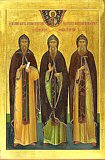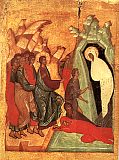

| Previous day | Next day |
| Old Style
March 29
|
Saturday |
New Style
April 11
|
|
Sixth Week of Great Lent (Palm Week). Lazarus Saturday.
Tone 1.
Great Lent. Caviar, wine and oil allowed. |
Caviar, wine and oil allowed.
|
![]() Lazarus Saturday
Lazarus Saturday ![]() St. Mark the Confessor, bishop of Arethusa, and with him Hieromartyr Cyril, deacon, of Heliopolis, and others, who suffered under Julian the Apostate (ca. 363).
St. Mark the Confessor, bishop of Arethusa, and with him Hieromartyr Cyril, deacon, of Heliopolis, and others, who suffered under Julian the Apostate (ca. 363).
St. John, hermit of Egypt (4th c.). St. Eustasius, abbot, of Luxeuil (9th c.). Sts. Mark (15th c.) and Jonah (1480) of the Pskov Caves Monastery. St. Nicetas, desert-dweller of the Roslavl Forests, near Bryansk (1793).
New Hieromartyr Michael Viktorov, archpriest, of Boloshnevo (Ryazan) (1933). New Martyrs Priest Paul Voinarsky, and brothers Paul and Alexis Kiryan, of the Crimea (1919).
St. Diadochus, bishop of Photike in Epirus (ca. 486). St. Hesychius of Sinai (ca. 8th c.). St. Eustathius the Confessor, bishop of Kios in Bithynia (9th c.).
Thoughts for Each Day of the Year
According to the Daily Church Readings from the Word of God
By St. Theophan the Recluse

Saturday. [Heb. 12:28–13:8; John 11:1–45]
To whomever has work-loving Martha, who symbolizes comprehensive good works, and who has Mary sitting at Jesus’ feet, symbolizing an attentive and warm appeal to the Lord with all the heart, the Lord Himself will come and will resurrect Lazarus, who symbolizes his spirit, and will release him from all his emotional and fleshly bonds. Then a truly new life will begin in him, bodiless in the body and unearthly on the earth. It will be a true resurrection in the spirit before the future resurrection, which will be together with the body!
Articles
 Hieromartyr Mark the Bishop of Arethusa, who suffered under Julian the ApostateHieromartyr Mark, Bishop of Arethusa, suffered for his faith in Christ under the emperor Julian the Apostate (361-363). |
 Martyr Cyril the Deacon of Heliopolis, who suffered under Julian the ApostateSaint Cyril destroyed many idols and pagan temples in Heliopolis, Phoenicia. |
 Venerable Mark of the Pskov CavesOf the first Elders of the Pskov Caves monastery only Mark is known by name. |
 Venerable Jonah (John) of the Pskov CavesThe priest John (nicknamed “Shestnik”) came to this holy spot, where the first ascetics prayed. |





